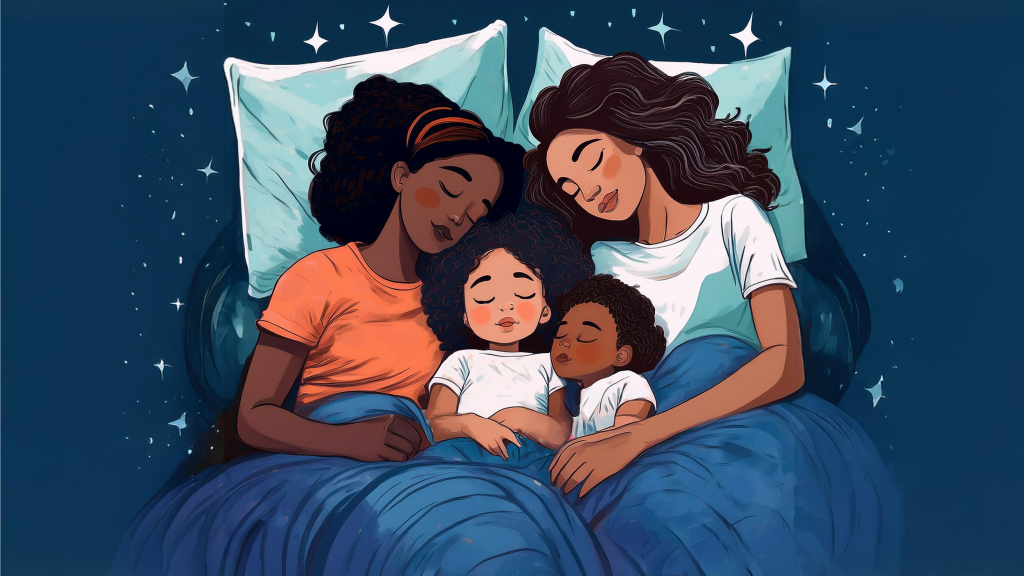Written by Jazmin Galdino (Psychologist, Childhood Sleep Neuroscience and Perinatal Mental Health Specialist)
How many of us, as children, didn’t want to sleep with our parents at least once—or perhaps many times?
One of the most common questions parents ask themselves is: Are we doing something wrong by allowing our child to sleep with us? This question often leads to the debate.
Co-sleeping: Yes or No?
When deciding as a family whether to practice co-sleeping, it might be helpful to reflect on how we slept during our own childhood. Did we enjoy sleeping alone, or did we prefer the comfort of sleeping next to our parents? Here, we find ourselves balancing between what is natural and what is cultural.
Today, parents are caught in the dichotomy between what feels natural and what society deems normal.
The Natural vs. The Cultural
From a natural perspective, sleeping together has been a part of human behavior since the beginning. Early humans slept in groups for protection against predators and other dangers, finding security in the presence of others. This is an instinct that remains deeply rooted in our biology.
On the other hand, cultural norms often dictate that children should sleep alone from an early age. These societal views are framed as universal truths but are often based more on the current needs of society than on what’s genuinely healthy for a child’s emotional and physical development.Today, parents are caught in the dichotomy between what feels natural and what society deems normal. However, when aiming for what’s truly healthy, it’s important to ask: What’s happening with our babies and young children?
Co-sleeping allows for an exchange of sensory and emotional signals, providing a sense of security.
Understanding the Needs of Babies and Young Children
The human baby is one of the most vulnerable of all mammals at birth, entirely dependent on caregivers for food, warmth, and protection. Given this, it’s entirely logical that a baby would cry when separated from their mother’s warmth and nourishment. Similarly, young children may want to sleep with their parents when they feel frightened or insecure during their early years.
Despite this, modern discourse often warns against “spoiling” children by allowing co-sleeping, skin-to-skin contact, or frequent carrying. Instead, parents are encouraged to make their children sleep alone from a young age, leading to tearful nights and children who eventually fall asleep—exhausted from stress. This approach tends to prioritize societal convenience over the emotional needs of the child.
These views are more about fulfilling societal expectations than addressing the natural needs of babies and providing realistic advice to parents. It’s essential to remember that for millions of years, children have been sleeping close to their parents. This behavior is not only expected but biologically normal.
Balancing the natural instincts of children with the cultural expectations of society can be challenging for parents.
The Benefits of Co-Sleeping
From a naturally human perspective, babies are wired to sleep with their parents. Co-sleeping allows for an exchange of sensory and emotional signals, providing a sense of security. In addition to being natural, co-sleeping offers several significant benefits:
- Enhanced breastfeeding: Co-sleeping facilitates easier access to breastfeeding, promoting bonding and supporting the establishment of a strong breastfeeding routine.
- Skin-to-skin contact: This type of contact boosts neurological and emotional development in infants.
- Reduced stress: Babies often stop crying as soon as they are near or in the arms of their parents, reducing unnecessary stress.
- Secure attachment: Co-sleeping helps build a secure emotional attachment between children and their caregivers.
- Improved sleep for the whole family: When sleeping close together, family members’ sleep cycles often synchronize, promoting a deeper, more restful sleep.
Safety First
If you choose to practice co-sleeping, it’s important to follow the safety guidelines recommended by the World Health Organization (WHO) and the Pediatric Association of your country. These guidelines are designed to ensure a safe and happy sleeping environment for both parents and children.
Conclusion: For a Peaceful, Safe, and Happy Sleep
Balancing the natural instincts of children with the cultural expectations of society can be challenging for parents. However, understanding the natural benefits of co-sleeping—while ensuring safety measures are in place—can lead to a healthier, happier, and more restful sleep for everyone in the family.
